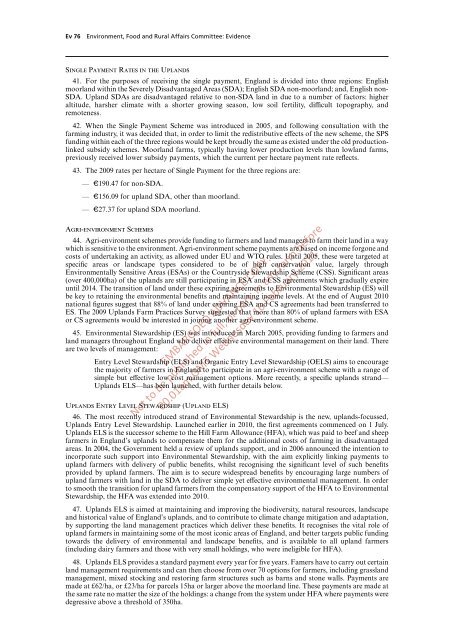Farming in the Uplands - ARCHIVE: Defra
Farming in the Uplands - ARCHIVE: Defra
Farming in the Uplands - ARCHIVE: Defra
You also want an ePaper? Increase the reach of your titles
YUMPU automatically turns print PDFs into web optimized ePapers that Google loves.
Ev 76 Environment, Food and Rural Affairs Committee: Evidence<br />
S<strong>in</strong>gle Payment Rates <strong>in</strong> <strong>the</strong> <strong>Uplands</strong><br />
41. For <strong>the</strong> purposes of receiv<strong>in</strong>g <strong>the</strong> s<strong>in</strong>gle payment, England is divided <strong>in</strong>to three regions: English<br />
moorland with<strong>in</strong> <strong>the</strong> Severely Disadvantaged Areas (SDA); English SDA non-moorland; and, English non-<br />
SDA. Upland SDAs are disadvantaged relative to non-SDA land <strong>in</strong> due to a number of factors: higher<br />
altitude, harsher climate with a shorter grow<strong>in</strong>g season, low soil fertility, diYcult topography, and<br />
remoteness.<br />
42. When <strong>the</strong> S<strong>in</strong>gle Payment Scheme was <strong>in</strong>troduced <strong>in</strong> 2005, and follow<strong>in</strong>g consultation with <strong>the</strong><br />
farm<strong>in</strong>g <strong>in</strong>dustry, it was decided that, <strong>in</strong> order to limit <strong>the</strong> redistributive eVects of <strong>the</strong> new scheme, <strong>the</strong> SPS<br />
fund<strong>in</strong>g with<strong>in</strong> each of <strong>the</strong> three regions would be kept broadly <strong>the</strong> same as existed under <strong>the</strong> old productionl<strong>in</strong>ked<br />
subsidy schemes. Moorland farms, typically hav<strong>in</strong>g lower production levels than lowland farms,<br />
previously received lower subsidy payments, which <strong>the</strong> current per hectare payment rate reflects.<br />
43. The 2009 rates per hectare of S<strong>in</strong>gle Payment for <strong>the</strong> three regions are:<br />
— ƒ190.47 for non-SDA.<br />
— ƒ156.09 for upland SDA, o<strong>the</strong>r than moorland.<br />
— ƒ27.37 for upland SDA moorland.<br />
Agri-environment Schemes<br />
44. Agri-environment schemes provide fund<strong>in</strong>g to farmers and land managers to farm <strong>the</strong>ir land <strong>in</strong> a way<br />
which is sensitive to <strong>the</strong> environment. Agri-environment scheme payments are based on <strong>in</strong>come forgone and<br />
costs of undertak<strong>in</strong>g an activity, as allowed under EU and WTO rules. Until 2005, <strong>the</strong>se were targeted at<br />
specific areas or landscape types considered to be of high conservation value, largely through<br />
Environmentally Sensitive Areas (ESAs) or <strong>the</strong> Countryside Stewardship Scheme (CSS). Significant areas<br />
(over 400,000ha) of <strong>the</strong> uplands are still participat<strong>in</strong>g <strong>in</strong> ESA and CSS agreements which gradually expire<br />
until 2014. The transition of land under <strong>the</strong>se expir<strong>in</strong>g agreements to Environmental Stewardship (ES) will<br />
be key to reta<strong>in</strong><strong>in</strong>g <strong>the</strong> environmental benefits and ma<strong>in</strong>ta<strong>in</strong><strong>in</strong>g <strong>in</strong>come levels. At <strong>the</strong> end of August 2010<br />
national figures suggest that 88% of land under expir<strong>in</strong>g ESA and CS agreements had been transferred to<br />
ES. The 2009 <strong>Uplands</strong> Farm Practices Survey suggested that more than 80% of upland farmers with ESA<br />
or CS agreements would be <strong>in</strong>terested <strong>in</strong> jo<strong>in</strong><strong>in</strong>g ano<strong>the</strong>r agri-environment scheme.<br />
45. Environmental Stewardship (ES) was <strong>in</strong>troduced <strong>in</strong> March 2005, provid<strong>in</strong>g fund<strong>in</strong>g to farmers and<br />
land managers throughout England who deliver eVective environmental management on <strong>the</strong>ir land. There<br />
are two levels of management:<br />
Entry Level Stewardship (ELS) and Organic Entry Level Stewardship (OELS) aims to encourage<br />
<strong>the</strong> majority of farmers <strong>in</strong> England to participate <strong>in</strong> an agri-environment scheme with a range of<br />
simple but eVective low cost management options. More recently, a specific uplands strand—<br />
<strong>Uplands</strong> ELS—has been launched, with fur<strong>the</strong>r details below.<br />
EMBARGOED ADVANCE COPY:<br />
Not to be published <strong>in</strong> full, or part, <strong>in</strong> any form before<br />
00.01am GMT Wednesday 16 February 2011<br />
<strong>Uplands</strong> Entry Level Stewardship (Upland ELS)<br />
46. The most recently <strong>in</strong>troduced strand of Environmental Stewardship is <strong>the</strong> new, uplands-focussed,<br />
<strong>Uplands</strong> Entry Level Stewardship. Launched earlier <strong>in</strong> 2010, <strong>the</strong> first agreements commenced on 1 July.<br />
<strong>Uplands</strong> ELS is <strong>the</strong> successor scheme to <strong>the</strong> Hill Farm Allowance (HFA), which was paid to beef and sheep<br />
farmers <strong>in</strong> England’s uplands to compensate <strong>the</strong>m for <strong>the</strong> additional costs of farm<strong>in</strong>g <strong>in</strong> disadvantaged<br />
areas. In 2004, <strong>the</strong> Government held a review of uplands support, and <strong>in</strong> 2006 announced <strong>the</strong> <strong>in</strong>tention to<br />
<strong>in</strong>corporate such support <strong>in</strong>to Environmental Stewardship, with <strong>the</strong> aim explicitly l<strong>in</strong>k<strong>in</strong>g payments to<br />
upland farmers with delivery of public benefits, whilst recognis<strong>in</strong>g <strong>the</strong> significant level of such benefits<br />
provided by upland farmers. The aim is to secure widespread benefits by encourag<strong>in</strong>g large numbers of<br />
upland farmers with land <strong>in</strong> <strong>the</strong> SDA to deliver simple yet eVective environmental management. In order<br />
to smooth <strong>the</strong> transition for upland farmers from <strong>the</strong> compensatory support of <strong>the</strong> HFA to Environmental<br />
Stewardship, <strong>the</strong> HFA was extended <strong>in</strong>to 2010.<br />
47. <strong>Uplands</strong> ELS is aimed at ma<strong>in</strong>ta<strong>in</strong><strong>in</strong>g and improv<strong>in</strong>g <strong>the</strong> biodiversity, natural resources, landscape<br />
and historical value of England’s uplands, and to contribute to climate change mitigation and adaptation,<br />
by support<strong>in</strong>g <strong>the</strong> land management practices which deliver <strong>the</strong>se benefits. It recognises <strong>the</strong> vital role of<br />
upland farmers <strong>in</strong> ma<strong>in</strong>ta<strong>in</strong><strong>in</strong>g some of <strong>the</strong> most iconic areas of England, and better targets public fund<strong>in</strong>g<br />
towards <strong>the</strong> delivery of environmental and landscape benefits, and is available to all upland farmers<br />
(<strong>in</strong>clud<strong>in</strong>g dairy farmers and those with very small hold<strong>in</strong>gs, who were <strong>in</strong>eligible for HFA).<br />
48. <strong>Uplands</strong> ELS provides a standard payment every year for five years. Famers have to carry out certa<strong>in</strong><br />
land management requirements and can <strong>the</strong>n choose from over 70 options for farmers, <strong>in</strong>clud<strong>in</strong>g grassland<br />
management, mixed stock<strong>in</strong>g and restor<strong>in</strong>g farm structures such as barns and stone walls. Payments are<br />
made at £62/ha, or £23/ha for parcels 15ha or larger above <strong>the</strong> moorland l<strong>in</strong>e. These payments are made at<br />
<strong>the</strong> same rate no matter <strong>the</strong> size of <strong>the</strong> hold<strong>in</strong>gs: a change from <strong>the</strong> system under HFA where payments were<br />
degressive above a threshold of 350ha.

















